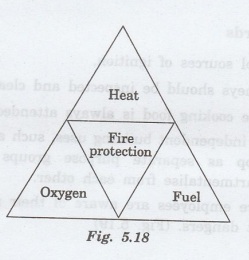Physics For Civil Engineering: Unit V: Natural Disasters
Fire Prevention and Safety Measures
Fire protection Triangle
A fire needs three elements heat, oxygen and fuel. Without heat, oxygen and fuel, a fire will not spread. A key strategy to prevent fire is to remove one or more of heat, oxygen or fuel.
FIRE
PREVENTION AND SAFETY MEASURES
Figure
5.18 shows Fire protection Triangle - Heat, oxygen and Fuel.

A
fire needs three elements heat, oxygen and fuel. Without heat,
oxygen and fuel, a fire will not spread. A key strategy to prevent fire is to
remove one or more of heat, oxygen or fuel. The risk assessment include detail
on the three elements to minimise the risk of fire spreading.
Heat
The heat must be controlled and kept
away from fuel. Heat generated as by product of a process must be removed
properly. (Fig. 5.19)

Heat Safeguards
1.
Control
sources of ignition.
2. Chimneys should be inspected and cleaned regularly.
3.
Ensure cooking food is always attended.
4. Treat independent building uses, such
as an office over a shop as separate purpose groups and therefore
compartmentalise from each other.
5.
Ensure employees are aware of their responsibility to report dangers. (Fig.
5.19)
Smoking
1.
Providing "no smoking" signs at appropriate locations.
2.
Ensure smoking areas are away from flammable materials.
3.
Arrange for cigarettes and matches to be disposed of safely and away from other
combustible rubbish. (Fig. 5.19).
Plant
and Equipment
Plant
and equipment which is not properly maintained can cause fires.
1.
Ensure all work equipment protects against catching fire or overheating. no
gninis
2.
Have electrical equipment serviced regularly to prevent sparks and fires.no bas
3.
Properly clean and maintain heat producing equipment such as burners, heat
exchangers, boilers, oven, stoves, fryers. (Fig. 5.19).
Portable Heaters
1. Do not use portable heaters
unnecessarily.
2. They should have emergency tip-over switches
and thermostatic limiting controls.
3.
Turn them off if people leave the room or are going to sleep.
4.
Do not use them to dry clothes.
Hot
Work
Hot
work is work that might generate sufficient heat, sparks or flame to cause a
fire.
Hot
work includes welding, flame cutting, soldering, brazing, grinding and other
equipment incorporating a flame. Hot work can be very dangerous and stringent
controls must be in place Fig. (5.19)
•
Identify all hot works.
•
Only allow hot work if no satisfactory alternative.
•
Ensure relevant contractors are aware of hot work procedures and controls.
Use
a hot work permit system including
•
Fire resistant protective clothing.
•
Clear responsibility.
•
Routine checking & supervision.
•
Provision of training on suitable fire fighting equipment.
•
Prevent, suppress and control heat and spark.
•
Remove or protect combustible or flammable materials.
Electrical
Safety
1.
Check electrical equipment and remove defective equipment.
2.
Ensure that electrical cords are in good condition.
3.
Plug appliances and lights in to separate electrical outlets.
4. Use extension cards safety - not
under carpets or across walking areas.
5.
Use only one device per outlet.
Oxygen
Air
we breathe contains about 21% oxygen. The pure oxygen at high pressure such as
from a cylinder, can react violently with common materials such as oil and
grease.
All
materials including textiles, rubber and even metals will burn vigorously in
oxygen.
Jaum
Even increase in the oxygen level to the air to 24%, it becomes easier to start
a fire, which will burn hotter and fiercely than in normal air. Ils vitnebl
Main
causes of fire and explosions when using oxygen are
(a)
Oxygen enrichment from leaking equipment.
(b)
Use of materials not compatible with oxygen.
(c)
Incorrect or careless operation of oxygen equipment.
Oxygen
Safeguards
1.
Prevent oxygen enrichment by ensuring that equipment is leak tight and in good
working.
2.
Check that ventilation is adequate.
3.
Always use oxygen cylinders and equipments carefully and correctly.
4. Never use oxygen equipment above the
pressures certified by the manufacturer.
5.
Never use oil or grease to lubricate oxygen equipment.
6.
Never use oxygen in equipment which is not designed for oxygen service.
Fuel
Fuel
consists of flammable material Flammable materials include
flammable liquids (e.g petrol), flammable gases (propane, butane) and flammable
solids (charcoal, paper).
Fuel
Safeguards
1.
Follow the authority's advice on LPG.
2.
Ensure employees are aware of their responsibility to report dangers.
3.
Permit no timber lining on ceilings, corridor walls or stairways.
4.
Provide gas detection equipment.
Physics For Civil Engineering: Unit V: Natural Disasters : Tag: : Fire protection Triangle - Fire Prevention and Safety Measures
Related Topics
Related Subjects
Physics for Civil Engineering
PH3201 2021 Regulation | 2nd Semester Civil Dept 2021 Regulation
